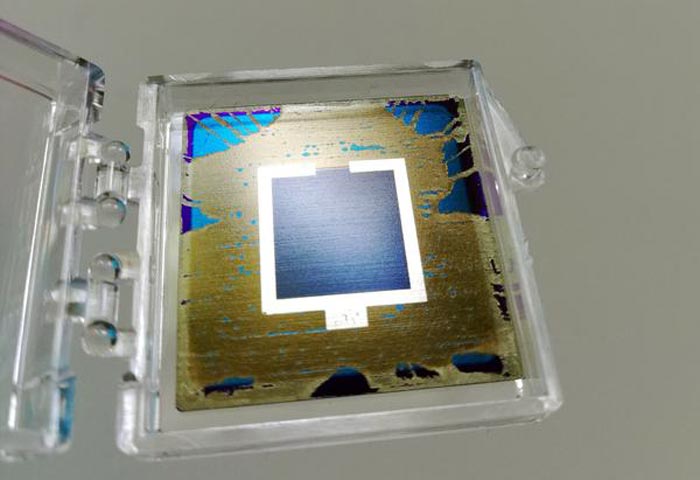“Workhorse” of photovoltaics combined with perovskite in tandem for the first time

A standard silicon solar cell is combined with a perovskite top cell. This tandem solar cell could reach high efficiencies.
Credit: Silvia Mariotti / HZB
Tandem cells made of silicon and perovskite are able to convert the broad energy spectrum of sunlight into electrical energy more efficiently than the respective single cells. Now, for the first time, two teams from HZB and ISFH Hameln have succeeded in combining a perovskite top cell with a so-called PERC/POLO silicon cell to form a tandem device.
This is an important achievement, since PERC silicon cells on p-type silicon are the “workhorse” of photovoltaics, with a market share of about 50% of all solar cells produced worldwide. They are largely optimised, long-term stable and temperature stable. Therefore, it is particularly interesting for the commercialisation of a perovskite-silicon tandem technology to develop a “perovskite tandem upgrade” for PERC cells.
The cooperation took place within the framework of the joint project P3T, which is funded by the Federal Ministry of Economics and coordinated by HZB.
The team at ISFH used an industry-compatible PERC process for the backside contact of the silicon bottom cells. On the front side of the wafer, another industrialisable technology was used, the so-called POLO contact, which was adapted here for the small-area proof of concept cells.
Perovskite expertise at HZB
The following process steps took place at HZB: A tin-doped indium oxide recombination layer was applied as a contact between the two subcells. On top of this, a perovskite cell was processed with a layer sequence similar to that in the current world record tandem cell on n-type silicon heterojunction cells, made by HZB.
The first perovskite PERC/POLO tandem cells produced in this way achieve an efficiency of 21.3% on an active cell area of about 1 cm². This efficiency is thus still below the efficiency of optimised PERC cells in this feasibility study. “However, initial experimental results and optical simulations indicate that we can significantly improve the performance through process and layer optimisation,” explains Dr. Lars Korte, the corresponding author of the study.
PCE estimated at 29,5 %
The experts estimate the Power Conversion Efficiency (PCE) of these perovskite/silicon tandem solar cells with PERC-like sub-cell technology at 29.5 %. The next steps for further efficiency increases are already clear: Dr. Silvia Mariotti from the HZB team had identified the coverage of the silicon surface by the perovskite as potential for improvement: “For this purpose, one could adapt the surface of the silicon wafers and thus quickly increase the efficiency to about 25%,” says Mariotti. This is then already significantly higher than the efficiency of PERC single cells.
Journal: Solar RRL
DOI: 10.1002/solr.202101066
Method of Research: Experimental study
Subject of Research: Not applicable
Article Title: Monolithic Perovskite/Silicon Tandem Solar Cells fabricated using industrial p-type POLO/PERC Silicon Bottom Cell Technology
Article Publication Date: 8-Feb-2022
COI Statement: none
Media Contact
Antonia Roetger
Helmholtz-Zentrum Berlin für Materialien und Energie
antonia.roetger@helmholtz-berlin.de
Office: 0049-308-062-43733
Original Source
All latest news from the category: Power and Electrical Engineering
This topic covers issues related to energy generation, conversion, transportation and consumption and how the industry is addressing the challenge of energy efficiency in general.
innovations-report provides in-depth and informative reports and articles on subjects ranging from wind energy, fuel cell technology, solar energy, geothermal energy, petroleum, gas, nuclear engineering, alternative energy and energy efficiency to fusion, hydrogen and superconductor technologies.
Newest articles

A universal framework for spatial biology
SpatialData is a freely accessible tool to unify and integrate data from different omics technologies accounting for spatial information, which can provide holistic insights into health and disease. Biological processes…

How complex biological processes arise
A $20 million grant from the U.S. National Science Foundation (NSF) will support the establishment and operation of the National Synthesis Center for Emergence in the Molecular and Cellular Sciences (NCEMS) at…

Airborne single-photon lidar system achieves high-resolution 3D imaging
Compact, low-power system opens doors for photon-efficient drone and satellite-based environmental monitoring and mapping. Researchers have developed a compact and lightweight single-photon airborne lidar system that can acquire high-resolution 3D…





















